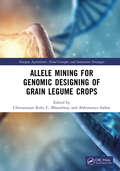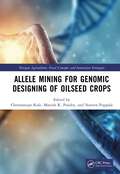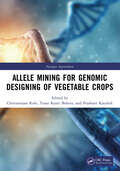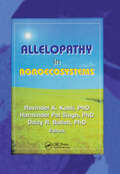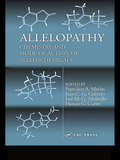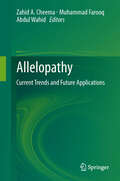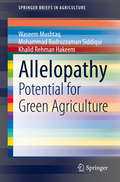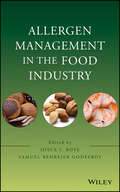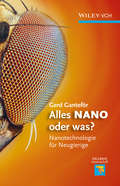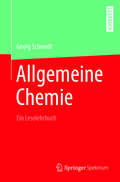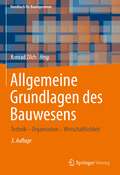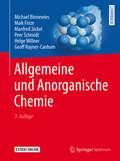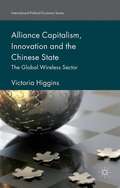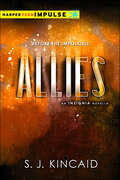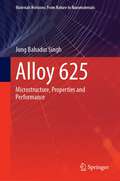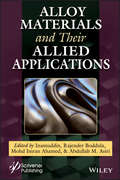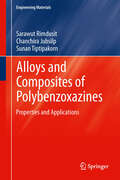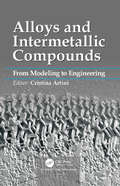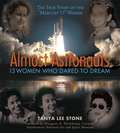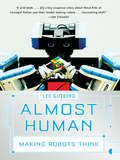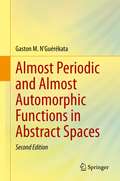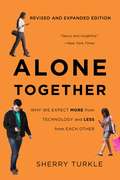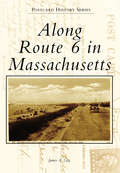- Table View
- List View
Allele Mining for Genomic Designing of Grain Legume Crops (Nextgen Agriculture)
by Chittaranjan Kole C. Bharadwaj Abhimanyu SarkarThis book deliberates on the concept, strategies, tools, and techniques of allele mining in grain legume crops and its application potential in genome elucidation and improvement, including studying allele evolution, discovery of superior alleles, discerning new haplotypes, assessment of intra- and interspecific similarity, and also studies of gene expression and gene prediction. Available gene pools in global germplasm collections specifically consisting of wild allied species and local landraces for almost all major crops have facilitated allele mining. Development of advanced genomic techniques, including PCR-based allele priming and EcoTILLING-based allele mining, is being widely used now for mining superior alleles. Allele's discovery has become more relevant now for employing molecular breeding to develop designed crop varieties matching consumer needs, and also with genome plasticity to adapt to climate change scenarios. All these concepts and strategies, along with precise success stories, are presented in the chapters dedicated to the major grain legume crops.1. The first book on the novel strategy of allele mining in grain legume crops for precise breeding.2. Presents genomic strategies for mining superior alleles underlying agronomic traits from genomic resources.3. Depicts case studies of PCR-based allele priming and EcoTILLING-based allele mining.4. Elaborates on gene discovery and gene prediction in major grain legume crops.This book will be useful to students and faculties in various plant science disciplines, including genetics, genomics, molecular breeding, agronomy, and bioinformatics; to scientists in seed industries; and also to policymakers and funding agencies interested in crop improvement.
Allele Mining for Genomic Designing of Oilseed Crops (Nextgen Agriculture)
by Chittaranjan Kole Manish K. Pandey Naveen PuppalaThis book deliberates on the concept, strategies, tools, and techniques of allele mining in oilseed crops and its application potential in genome elucidation and improvement, including studying allele evolution, discovery of superior alleles, discerning new haplotypes, assessment of intra- and interspecific similarity, and studies of gene expression and gene prediction. Available gene pools in global germplasm collections, specifically consisting of wild allied species and local landraces for almost all major crops, have facilitated allele mining. The development of advanced genomic techniques, including PCR-based allele priming and Eco-TILLING-based allele mining, is now widely used for mining superior alleles. Allele's discovery has become more relevant now for employing molecular breeding to develop designed crop varieties matching consumer needs and with genome plasticity to adapt to climate change scenarios. All these concepts and strategies, along with precise success stories, are presented in the chapters dedicated to the major oilseed crops.1. This is the first book on the novel strategy of allele mining in oilseed crops for precise breeding.2. This book presents genomic strategies for mining superior alleles underlying agronomic traits from genomic resources.3. This book depicts case studies of PCR-based allele priming and Eco-TILLING based allele mining.4. This book elaborates on gene discovery and gene prediction in major oilseed crops.This book will be useful to students and faculties in various plant science disciplines, including genetics, genomics, molecular breeding, agronomy, and bioinformatics; scientists in seed industries; and policymakers and funding agencies interested in crop improvement.
Allele Mining for Genomic Designing of Vegetable Crops (Nextgen Agriculture)
by Chittaranjan Kole Tusar Kanti Behera Prashant KaushikThis book deliberates on the concept, strategies, tools, and techniques of allele mining in vegetable crops and its application potential in genome elucidation and improvement including studying allele evolution, discovery of superior alleles, discerning new haplotypes, assessment of intra- and interspecific similarity, and studies of gene expression and gene prediction. Available gene pools in global germplasm collections specifically consisting of wild allied species and local landraces for almost all major crops have facilitated allele mining. Development of advanced genomic techniques including PCR-based allele priming and Eco-TILLING based allele mining are being widely used now for mining superior alleles. Allele's discovery has become more relevant now for employing molecular breeding to develop designed crop varieties matching consumer needs and with genome plasticity to adapt the climate change scenarios. All these concepts and strategies along with precise success stories are presented in the chapters dedicated to the major vegetable crops. The first book on the novel strategy of allele mining in vegetable crops for precise breeding Presents genomic strategies for mining superior alleles underlying agronomic traits from genomic resources Depicts case studies of PCR-based allele priming and Eco-TILLING based allele mining Elaborates on gene discovery and gene prediction in major vegetable crops This book will be useful to the students and faculties in various plant science disciplines including genetics, genomics, molecular breeding, agronomy, and bioinformatics; the scientists in seed industries; and, the policymakers and funding agencies interested in crop improvement.
Allelopathy in Agroecosystems
by Ravinder Kumar Kohli Harminder Pal Singh Daizy Rani BatishDiscover environmentally safe ways to control weeds and pests!Until now farmers have had to choose between using expensive herbicides and fertilizers, which pollute the water table, or watching crop yields drop. All too often, crop yields dropped anyway, despite intensive farming. Allelopathy in Agroecosystems offers fresh hope. It provides an in-depth understanding of allelopathy-the mysterious, complex biochemical interactions among plants and microbes. This little-understood phenomenon plays a large role in agriculture, for good or ill. It can lead to changes in nutrient dynamics, vegetation structure, and species diversity.This comprehensive treatise is the first compendium devoted to explaining and exploring these chemical interactions in agricultural crop systems. Allelopathy in Agroecosystems explains how these interactions can make soil “sick,” especially in intensively cropped areas. This leads to less growth and lower yield. On the other hand, it has great potential as an environmentally safe method of weed and pest management. The fascinating original research presented here will help you understand the complexities of this invisible yet potent force in agriculture.Allelopathy in Agroecosystems examines this interaction as it affects the most important concerns of farmers and agronomists, including: beneficial interactions between crops weed control using crop residues crop rotation natural herbicides genetic engineering soil rhizosphere bacteria improving pastures forest/crop interactions sustainable management of agroecosystems new directions for research International in scope, Allelopathy in Agroecosystems offers an abundance of scientific data on this revolutionary new concept. It offers incalculable potential for rescuing farmed-out land, increasing crop yields, and cutting back on expensive soil additives. Every agronomist, environmental scientist, policymaker, agricultural librarian, and advocate of sustainable farming needs this book.
Allelopathy: Chemistry and Mode of Action of Allelochemicals
by Francisco A. Macías Juan C. G. Galindo José M. G. Molinillo Horace G. CutlerMost, if not all, books on allelopathy cover the ecological, agronomic, and descriptive physiological aspects. And although the amount of papers published on the chemical aspects and mode of action of these compounds continues to rise, there has been, until now, no book available that reflects the latest literature. Written by experts, Allelopathy:
Allelopathy: Current Trends and Future Applications
by Muhammad Farooq Abdul Wahid Zahid A. CheemaAllelopathy is an ecological phenomenon by which plants release organic chemicals (allelochemicals) into the environment influencing the growth and survival of other organisms. In this book, leading scientists in the field synthesize latest developments in allelopathy research with a special emphasis on its application in sustainable agriculture. The following topics are highlighted: Ecological implications, such as the role of allelopathy during the invasion of alien plant species; regional experiences with the application of allelopathy in agricultural systems and pest management; the use of microscopy for modeling allelopathy; allelopathy and abiotic stress tolerance; host allelopathy and arbuscular mycorrhizal fungi; allelopathic interaction with plant nutrition; and the molecular mechanisms of allelopathy. This book is an invaluable source of information for scientists, teachers and advanced students in the fields of plant physiology, agriculture, ecology, environmental sciences, and molecular biology.
Allelopathy: Potential for Green Agriculture (SpringerBriefs in Agriculture)
by Khalid Rehman Hakeem Waseem Mushtaq Mohammad Badruzzaman SiddiquiAllelopathic studies may be defined in various aspects; weed against weed/crop and vice versa. This book focuses on the ways to utilize the allelopathic potential of weeds or crops for controlling weeds in the agroecosystems. Vigorous use of herbicides is poisoning our environment at an alarming rate; allelopathy can be employed as a useful alternative to control weeds naturally under field conditions. The book contains chapters on the history of allelopathy; allelopathic potential of several important crops (rice, wheat, sorghum, maize, mustard, sunflower) and weeds (members of Solanaceae, Convolvulaceae, Asteraceae, Verbenaceae). Moreover, it highlights how the allelopathic potential of these weeds and crops can be employed effectively to suppress weeds under field conditions. The book also discusses topics on the role of allelochemicals in agroecosystems; impact on local flora; biotic stress induced by allelochemicals; mechanism of action of allelochemicals and future prospective of allelopathy. Prepared with basic concepts and importance of allelopathy, this book is intended for the agricultural community, botanists, students and researchers.
Allergen Management in the Food Industry
by Joyce I. Boye Samuel Benrejeb GodefroyThis book comprehensively addresses the sources of allergenic contaminants in foods, their fate during processing, and the specific measures that need to be taken to minimize their occurrence in foods. The book provides up-to-date information on the nine major allergens (as well as other emerging allergens) and practical guidelines on how these allergens can be identified and controlled during production and processing. Starting with an introduction to food allergens, the book follows with sections on food allergen management during production and processing, guidelines for the processing of specific allergen-free foods, techniques for hypo-allergenization and allergen detection, and allergen-free certification.
Alles NANO - oder was?: Nanotechnologie für Neugierige (Erlebnis Wissenschaft)
by Gerd GanteförDie Perfektion der Mücke oder ein Reiseführer in die NANO-Welt Alles NANO, oder was? Das fragen sich immer mehr Menschen. Die Computer werden intelligenter, die Handys kleiner. Die Nanotechnologie bietet schon heute beachtliche Anwendungen. Noch mehr allerdings faszinieren die Möglichkeiten, die in der Zukunft liegen, zum Beispiel in der Medizin. Können spezielle Nanopartikel tatsächlich bald gezielt Krebszellen attackieren? Zeit für eine Bestandsaufnahme: Was ist Nanotechnologie? Wo kommt sie bereits zum Einsatz? Was kann sie in Zukunft leisten? Und welche Gefahren sind mit ihr verbunden? All diese Fragen beantwortet Gert Ganteför, im richtigen Leben Physikprofessor, in diesem dem Buch. Beste NANO-Lehrmeisterin: die Natur Die Natur ist dabei der reizvolle Ausgangspunkt des Buches, denn sie ist »die wahre Meisterin der Nanotechnologie«, wie Ganteför betont. Naheliegend dass der Autor zunächst einmal die Gesetze erklärt, die in der Welt der Moleküle, Atome und Quanten herrschen. Dringt man zum Beispiel in den Bereich von unter 100 Nanometern vor – zum Vergleich: Blutkörperchen sind zehnmal größer – spielen die Naturgesetze verrückt. Elektronen fliegen durch Barrieren, Teilchen können an mehreren Orten gleichzeitig sein und auch das Licht verlässt seine Bahnen. Der Mensch beginnt gerade erst zu verstehen, welche Chancen und Risiken dieser noch unerforschte Bereich bereithält. Dieses Buch ist der unverzichtbare Reiseführer in die Welt der Nanotechnologie – verständlich, unterhaltsam, spannend.
Allgemeine Chemie - ein Leselehrbuch
by Georg SchwedtDas Buch soll das Chemiewissen vermitteln, das nach #65533;berzeugung des Autors zur Allgemeinbildung geh#65533;rt. Dazu bedient es sich in erster Linie der Sprache, die - wo n#65533;tig - durch chemische Formeln und Gleichungen erg#65533;nzt wird. Auf diese Weise schl#65533;gt das Buch eine Br#65533;cke zwischen der Schulbildung und universit#65533;rer Lehre, so dass es eine Empfehlung f#65533;r Studierende aller Fachrichtungen ist, die ihre erste Chemie-Vorlesung h#65533;ren. Sch#65533;ler, Lehrer und interessierte Laien k#65533;nnen ihr Chemiewissen ebenfalls auffrischen und erweitern.
Allgemeine Grundlagen des Bauwesens: Technik – Organisation – Wirtschaftlichkeit (Handbuch für Bauingenieure)
by Konrad ZilchDer vorliegende Band aus der Reihe Handbuch für Bauingenieure erläutert wichtige grundlegende und aktuelle Inhalte der Fachgebiete Ingenieurgeodäsie, Bauphysik, Bauchemie, Bauinformatik, Theorie der Tragwerke und Zuverlässigkeit von Tragwerken. Die Vorhersage des Verhaltens von Tragwerken unter den unterschiedlichen Beanspruchungen stellt eine Kernaufgabe entwerfender Ingenieure dar und liefert die Basis für die Dimensionierungsaufgaben im Konstruktiven Ingenieurbau. Die hierzu erforderlichen Theorien und Modelle der Geodäsie, Bauphysik und der Tragwerke sowie deren Umsetzung in Analysemethoden werden in den Kapiteln schrittweise aus den Grundlagen der technischen Mechanik bis zu Berechnungskonzepten und deren algorithmischen Umsetzungen entwickelt. Ein wesentliches Ziel dieses Buches ist es, dem Leser die Fähigkeit zu verleihen, die gewonnenen Ergebnisse in die Anschauungswelt seiner Entwürfe und Konstruktionen zu übertragen, um sie dort nachvollziehen zu können und stets kritisch zu hinterfragen.Das Handbuch für Bauingenieure bietet Grundwissen kompakt, vollständig und aktuell. Neben den klassischen Fächern des Konstruktiven Ingenieurbaus zählt dazu verstärkt das Fachwissen über das Bau-, Immobilien- und Unternehmensmanagement sowie das Baurecht. Darüber hinaus behandeln ausgewiesene Fachautoren die weiteren Kerngebiete des Bauingenieurs: Geotechnik, Wasserbau, Siedlungswasserwirtschaft, Abfalltechnik, Raumordnung und Städtebau sowie Verkehrssysteme und –anlagen. Das Handbuch wurde den aktuellen Normen und Richtlinien angepasst und versteht sich als Lehrbuch für Studierende und Nachschlagewerk für Praktiker.
Allgemeine und Anorganische Chemie
by Peer Schmidt Michael Binnewies Maik Finze Manfred Jäckel Helge Willner Geoff Rayner-CanhamDieses erfolgreiche Lehrbuch der Allgemeinen und Anorganischen Chemie baut auf der im angloamerikanischen Raum seit vielen Auflagen bewährten Einführung Descriptive Inorganic Chemistry von Geoff Rayner-Canham auf. Die Übersetzung des Werkes ist von den deutschen Co-Autoren Michael Binnewies, Manfred Jäckel und Helge Willner vollständig überarbeitet und wesentlich erweitert worden, um den Text auf die Bedürfnisse der Chemiestudierenden im Haupt- und Nebenfach im deutschsprachigen Raum zuzuschneiden. Für die 2. Auflage haben sie zahlreiche neue Inhalte eingearbeitet, etwa zur Molekülsymmetrie, zu ionischen Flüssigkeiten, zu Biomineralen und Kohlenstoff-Nanoröhren. Viele Abschnitte sind erweitert, etliche Abbildungen verändert oder neu erstellt worden. Das klar gegliederte und verständlich geschriebene Lehrbuch umfasst in einem ausgewogenen Verhältnis eine praxisgerechte Allgemeine Chemie und einen soliden Überblick über die Chemie anorganischer Stoffe. Vielfach werden auch Beziehungen zu den Nachbarwissenschaften Physik und Biologie berücksichtigt. Einen Schwerpunkt im Bereich der Allgemeinen Chemie bildet die Verknüpfung mit den zentralen Inhalten der Ausbildung in den Praktika. Die Präsentation der Stoffchemie im zweiten Teil des Buches folgt dem Periodensystem und geht dabei überwiegend exemplarisch vor. Im Vordergrund steht hier das Verständnis für die Eigenschaften der wichtigsten Stoffe und ihre Anwendung in Labor, Technik und Alltag, nicht eine (tendenziell enzyklopädische) Stoffsystematik. Der Zusammenhang mit grundlegenden allgemein-chemischen Konzepten wird sorgfältig herausgearbeitet. Zahlreiche Exkurse geben nähere Einblicke in aktuelle Technologien, in wissenschaftshistorische Zusammenhänge und Umweltprobleme. Eigene Kapitel zu den Grundlagen der Physik und der praktischen Mathematik ermöglichen eine Rekapitulation naturwissenschaftlichen Basiswissens. Eine umfangreiche Datensammlung rundet das Werk ab. Das Buch ist durchgehend zweifarbig illustriert, umfasst ein Glossar sowie zahlreiche Übungsaufgaben zu jedem Kapitel. Auf der buchbegleitenden Website findet man die Antworten zu diesen Fragen sowie eine Sammlung von Farbfotos, die einen Eindruck vom Erscheinungsbild vieler Elemente, Laborreagenzien und Mineralien liefern. Eine Bild-DVD für Dozenten mit allen Grafiken des Buches ist separat erhältlich, ebenso ein Arbeitsbuch für Studierende mit zahlreichen weiteren Übungsaufgaben zu den wichtigsten Themen der Allgemeinen Chemie.
Alliance Capitalism, Innovation and the Chinese State: The Global Wireless Sector (International Political Economy Series)
by Victoria HigginsThis book analyses how key 'systems integration' technical pressures, and the increasing use of collaborative alliances for market and product development are impacting on the socio technical policy directives of Chinese State leaders and the strategic behaviour of key Chinese high technology firms operating in the global wireless sector.
Allies: An Insignia Novella (The Insignia Novels)
by S. J. KincaidIn S. J. Kincaid's fast-paced and humorous sci-fi Insignia trilogy, the earth is in the middle of World War III when teen gamer Tom Raines is recruited to train with other young cadets as a pivotal member of the elite combat corps, the Intrasolar Forces. At the Pentagonal Spire's training academy, he makes the best friends of his life—fellow government weapons-in-training Wyatt Enslow, Vik Ashwan, and Yuri Sysevich.In this 47-page prequel novella to the series, budding genius Wyatt Enslow—intensely loyal and hyperintelligent if occasionally, hilariously, socially awkward—takes center stage as S. J. Kincaid reveals Wyatt's life before she found her place, and her own inner strength, among her devoted band of friends at the Spire.Praise for Insignia: "The characters are real, funny, and memorable. You won't be able to put this book down."—Veronica Roth, New York Times bestselling author of DivergentEpic Reads Impulse is a digital imprint with new releases each month.
Alloy 625: Microstructure, Properties and Performance (Materials Horizons: From Nature to Nanomaterials)
by Jung Bahadur SinghThis book gives a brief history of the development of Alloy 625 and a detailed account of its physical, mechanical, and corrosion properties. It also addresses different types of microstructural changes the Alloy 625 undergoes at intermediate temperatures; provides details of properties deterioration due to such microstructural changes; assesses the alloy damage during the in-service inspection of plants; and provides criteria for the damage evaluation for various destructive and non-destructive testing. It combines the industrial data and literature together in one place for damage assessment of service exposed Alloy 625 components. This book serves as a guide to practicing engineers in the industry interested in the use of Alloy 625 and in academia for students pursuing advanced courses in materials science. Alloy 625 is a versatile nickel-chromium-molybdenum alloy known for its unique combination of high strength, excellent fabricability and weldability, and outstanding corrosion resistance.
Alloy Materials and Their Allied Applications
by Inamuddin Abdullah M. Asiri Mohd Imran Ahamed Rajender BoddulaAlloy Materials and Their Allied Applications provides an in-depth overview of alloy materials and applications. The 11 chapters focus on the fabrication methods and design of corrosion-resistant, magnetic, biodegradable, and shape memory alloys. The industrial applications in the allied areas, such as biomedical, dental implants, abrasive finishing, surface treatments, photocatalysis, water treatment, and batteries, are discussed in detail. This book will help readers solve fundamental and applied problems faced in the field of allied alloys applications.
Alloys Based on TiNi in Pre-transition Low-Stability States: Structure and Properties (Advanced Structured Materials #216)
by Alexander I. Potekaev Anatoly A. Klopotov Valentina V. Kulagina Yulia V. Solov'eva Sergey G. AnikeevThis book presents the results of research on the regularities during thermocyclic impact on changes in structural-phase states of functional alloys with low-stability or instability in the area of structural-phase transformations. Without clarification of the physical regularities of the influence of thermomechanical impact on the properties of alloys, it is impossible to develop technological processes of processing functional materials; therefore, the book widely uses the results of many years of research by the authors of the book. It is known that critical temperatures and stresses for martensitic transformation, for example, B 2↔︎ B 19′, in NiTi are very sensitive to cycling. The study of structural-phase states, corresponding to changes in physical-mechanical properties of intermetallics in the area of transformations, is a necessary aspect of understanding the nature of the influence of thermomechanical cycling on the properties of functional alloys. This book is dedicated to the fundamental physical aspects of stability, the influence of structural defects on properties and structural-phase transformations of FCC alloys. This book is useful for a wide range of specialists—scientific researchers and engineers, working in the field of materials science and physics of condensed systems, as well as teachers, postgraduates and students, specializing in the field of materials science.
Alloys and Composites of Polybenzoxazines: Properties and Applications (Engineering Materials)
by Chanchira Jubsilp Sarawut Rimdusit Sunan TiptipakornThis book provides an introduction to the unique and fascinating properties of alloys and composites from novel commercialized thermosetting resins based on polybenzoxazines. Their outstanding properties such as processability, thermal, mechanical, electrical properties as well as ballistic impact properties of polybenzoxazine alloys and composites make them attractive for various applications in electronic packaging encapsulation, light weight ballistic armour composites and bipolar plate in fuel cells.
Alloys and Intermetallic Compounds: From Modeling to Engineering
by Cristina ArtiniThis book focuses on the role of modeling in the design of alloys and intermetallic compounds. It includes an introduction to the most important and most used modeling techniques, such as CALPHAD and ab-initio methods, as well as a section devoted to the latest developments in applications of alloys. The book emphasizes the correlation between modeling and technological developments while discussing topics such as wettability of Ultra High Temperature Ceramics by metals, active brazing of diamonds to metals in cutting tools, surface issues in medicine, novel Fe-based superconductors, metallic glasses, high entropy alloys, and thermoelectric materials.
Almost Astronauts: 13 Women Who Dared to Dream
by Tanya Lee StoneNearly twenty years before the first women were allowed into NASA's astronaut program, a group of thirteen women proved not only that they were as tough as any man but also that they were brave enough to challenge the government. Almost Astronauts tells the story of the "Mercury 13" women, who were blocked by prejudice, jealousy, and a note scrawled by one of the most powerful men in Washington. In the end, the inspiring example of these space-age pioneers empowered young people to take their rightful place in the sky and beyond, piloting jets and commanding space capsules.<P><P> Winner of the Sibert Medal
Almost Human: Making Robots Think
by Lee GutkindA remarkable, intense portrait of the robotic subculture and the challenging quest for robot autonomy. The high bay at the Robotics Institute at Carnegie Mellon University is alive and hyper night and day with the likes of Hyperion, which traversed the Antarctic, and Zoe, the world's first robot scientist, now back home. Robot Segways learn to play soccer, while other robots go on treasure hunts or are destined for hospitals and museums. Dozens of cavorting mechanical creatures, along with tangles of wire, tools, and computer innards are scattered haphazardly. All of these zipping and zooming gizmos are controlled by disheveled young men sitting on the floor, folding chairs, or tool cases, or huddled over laptops squinting into displays with manic intensity. Award-winning author Lee Gutkind immersed himself in this frenzied subculture, following these young roboticists and their bold conceptual machines from Pittsburgh to NASA and to the most barren and arid desert on earth. He makes intelligible their discoveries and stumbling points in this lively behind-the-scenes work.
Almost Periodic and Almost Automorphic Functions in Abstract Spaces
by Gaston M. N'GuérékataThis book presents the foundation of the theory of almost automorphic functions in abstract spaces and the theory of almost periodic functions in locally and non-locally convex spaces and their applications in differential equations. Since the publication of Almost automorphic and almost periodic functions in abstract spaces (Kluwer Academic/Plenum, 2001), there has been a surge of interest in the theory of almost automorphic functions and applications to evolution equations. Several generalizations have since been introduced in the literature, including the study of almost automorphic sequences, and the interplay between almost periodicity and almost automorphic has been exposed for the first time in light of operator theory, complex variable functions and harmonic analysis methods. As such, the time has come for a second edition to this work, which was one of the most cited books of the year 2001.This new edition clarifies and improves upon earlier materials, includes many relevant contributions and references in new and generalized concepts and methods, and answers the longtime open problem, "What is the number of almost automorphic functions that are not almost periodic in the sense of Bohr?" Open problems in non-locally convex valued almost periodic and almost automorphic functions are also indicated.As in the first edition, materials are presented in a simplified and rigorous way. Each chapter is concluded with bibliographical notes showing the original sources of the results and further reading.
Aloft! The Story of the First Hot-Air Balloon Flight / Pedaling Through the Sky (Fountas & Pinnell Classroom, Guided Reading Grade 5)
by Giorgio Bacchin Timothy PaulsonNIMAC-sourced textbook
Alone Together: Why We Expect More from Technology and Less from Each Other
by Sherry TurkleConsider Facebook--it's human contact, only easier to engage with and easier to avoid. Developing technology promises closeness. Sometimes it delivers, but much of our modern life leaves us less connected with people and more connected to simulations of them. In Alone Together, MIT technology and society professor Sherry Turkle explores the power of our new tools and toys to dramatically alter our social lives. It's a nuanced exploration of what we are looking for--and sacrificing--in a world of electronic companions and social networking tools, and an argument that, despite the hand-waving of today's self-described prophets of the future, it will be the next generation who will chart the path between isolation and connectivity.
Along Route 6 in Massachusetts (Postcard History Series)
by James A. GayRoute 6 in Massachusetts runs from Provincetown to Seekonk and passes through some of the most beautiful scenery in the state. What had once been a mere footpath for Native Americans, then widened for the use of stagecoaches, Route 6 would be officially designated the “King’s Highway” in 1920. The moniker was extremely unpopular with the local residents, so much so that the governor officially changed the name to the Grand Army of the Republic Highway in 1937. Depicted from the author’s personal collection of postcards from the 1920s to the 1960s, Route 6 winds its way around tiny fishing villages, sand dunes, marshes, beaches, lighthouses, campgrounds, hotels, restaurants, and historic cities. The combination of Route 6 and the automobile would make Cape Cod a world-renowned tourist destination.
